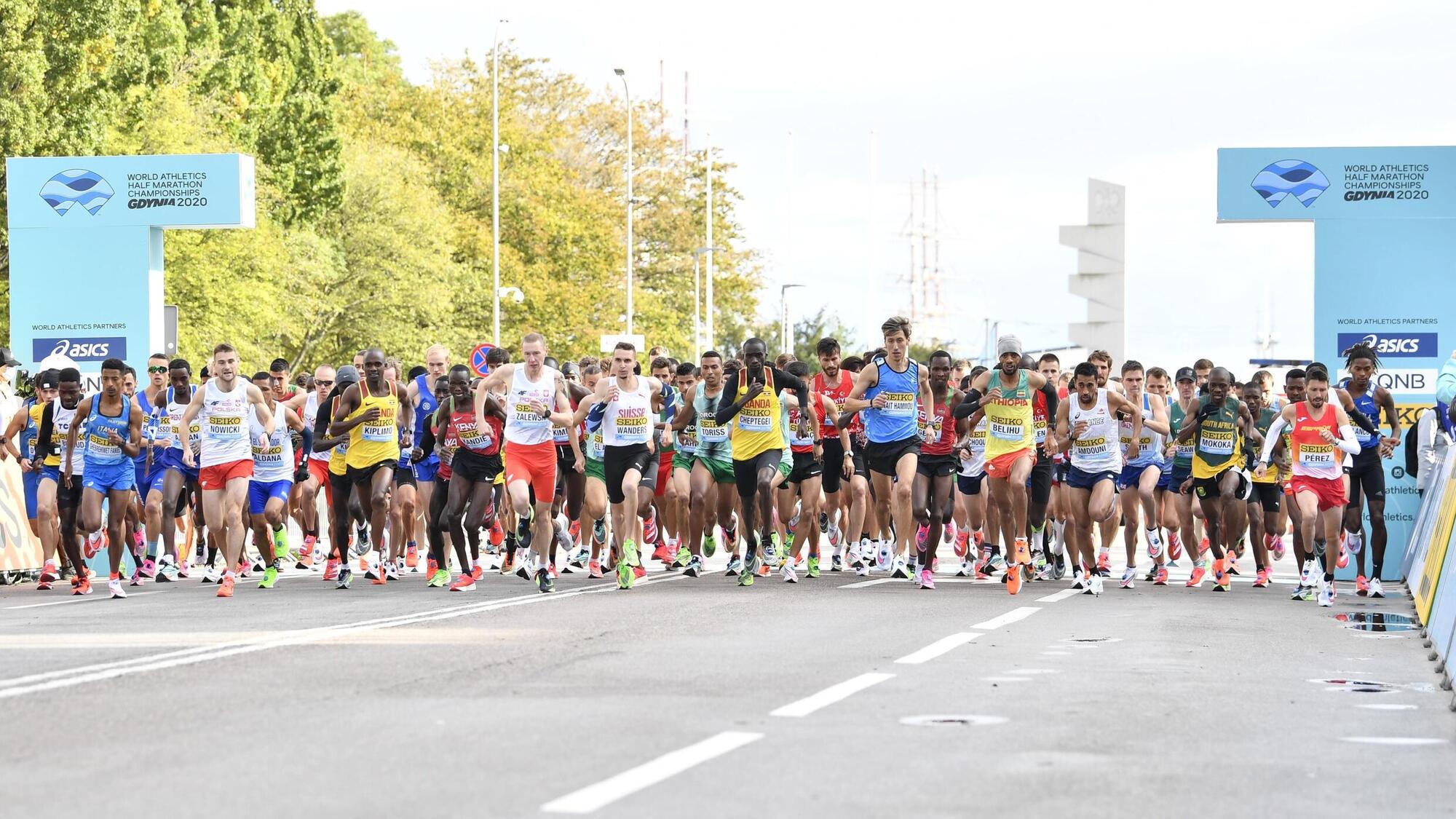

Featured
How To Train For Half Marathon Beginner
Modified: August 21, 2023
Get ready to conquer your first half marathon with our comprehensive training guide for beginners. Learn the essential tips and techniques from our featured experts to ensure a successful race day.
Introduction
So, you’ve decided to take on the challenge of running a half marathon. Congratulations! This is an exciting and rewarding endeavor that will push you both mentally and physically. Whether you’re a complete beginner or have some experience with running, training for a half marathon requires a well-rounded approach to ensure you reach the finish line strong and injury-free.
In this article, we will guide you through the process of training for a half marathon, providing you with valuable tips and insights to help you prepare effectively. From setting goals to choosing the right gear, from building endurance to incorporating speed work, we will cover all aspects of training to ensure you have a successful and enjoyable experience.
Before we dive into the specifics, it’s important to note that training for a half marathon requires commitment, dedication, and patience. It’s not a race that can be taken lightly, but with the right mindset and preparation, you can achieve your goal of crossing that finish line.
Throughout your training journey, it’s essential to listen to your body and make adjustments as needed. Remember, everyone’s fitness level and running background are different, so it’s crucial to tailor the training plan to suit your individual needs.
Now, let’s get started on this exciting adventure as we guide you through the process of training for a half marathon. Lace up your running shoes and get ready to embark on a journey of self-discovery, resilience, and accomplishment. Your half marathon journey starts here!
Setting Goals
Setting clear and achievable goals is a critical step in training for a half marathon. Whether it’s your first race or you’re looking to beat a personal record, having a goal in mind will provide you with focus and motivation throughout your training journey.
When setting goals, it’s essential to make them specific, measurable, attainable, relevant, and time-bound, also known as SMART goals. For example, instead of saying, “I want to finish the half marathon,” you could set a SMART goal like, “I want to complete the half marathon in under 2 hours and 30 minutes by the end of three months of training.”
It’s important to set realistic goals that consider your current fitness level and running experience. If you’re a beginner, aiming for a sub-2 hour finish time might not be attainable right away. Start by focusing on completing the race and gradually work towards improving your pace in future races.
Additionally, setting both short-term and long-term goals can help you stay motivated and focused. Short-term goals can be weekly or monthly targets, such as increasing your weekly mileage or improving your speed during interval workouts. Long-term goals can be achieving a specific finish time or completing multiple half marathons in a year.
Remember to write down your goals and keep them somewhere visible, like a training journal or a poster on your wall. This visual reminder will serve as a constant motivator and keep you accountable throughout your training.
Lastly, it’s important to prioritize enjoyment and personal growth as part of your goals. While it’s great to strive for a specific finish time, training for a half marathon should also be a journey of self-discovery and pushing your limits. Embrace the process, celebrate small victories, and enjoy the experience of training for and participating in a half marathon.
Creating a Training Plan
Once you have set your goals, the next step is to create a well-structured training plan that will gradually build your endurance and get you race-ready. A training plan serves as a roadmap for your journey, outlining the number of days you will run, the distances you will cover, and the types of workouts you will incorporate.
When designing your training plan, it’s important to consider your current fitness level, running experience, and time availability. The plan should be challenging enough to help you progress but also flexible enough to accommodate potential life commitments or unexpected events.
Start by determining the duration of your training plan. Most training plans range from 10-16 weeks, depending on your fitness level and race date. It’s recommended to allow sufficient time for gradual progression and recovery, especially if you’re a beginner.
Next, consider the number of days per week you will dedicate to running. Ideally, aim for a minimum of three to four days of running per week to allow for proper rest and recovery. This balanced approach will help prevent overtraining and reduce the risk of injury.
Within your training plan, incorporate a mix of easy runs, long runs, interval workouts, and cross-training. Easy runs should make up the majority of your weekly mileage and should be done at a comfortable pace that allows you to hold a conversation. Long runs, on the other hand, should gradually increase in distance each week to build endurance and mental strength.
Interval workouts, such as speed repeats or tempo runs, are crucial for improving your running speed and cardiovascular fitness. These workouts involve running at a faster pace for a set distance or time, followed by a short recovery period. Incorporating these workouts once or twice a week will help you develop speed and improve your race performance.
In addition to running, cross-training activities such as cycling, swimming, or strength training can help improve overall fitness and reduce the risk of injury. Include cross-training sessions in your training plan, aiming for at least one to two days per week.
Remember, consistency is key when following a training plan. Stick to your scheduled runs and workouts, but also listen to your body and make adjustments if needed. Be flexible and willing to adapt the plan if life circumstances or unexpected events arise.
By following a well-structured training plan, you’ll gradually build your fitness and endurance, increasing your chances of successfully completing the half marathon and achieving your goals.
Choosing the Right Gear
When it comes to training for a half marathon, having the right gear can make a significant difference in your comfort and performance. Here are some essential considerations when choosing the right gear for your training:
- Running Shoes: Invest in a good pair of running shoes that provide proper support, cushioning, and fit. Visit a specialty running store to get professionally fitted and find shoes suitable for your foot type and running style. Remember to replace your shoes every 300-500 miles to maintain optimal support.
- Moisture-Wicking Clothing: Opt for moisture-wicking and breathable fabrics to keep you comfortable and dry during runs. Look for shirts, shorts, and socks specifically designed for running to help prevent chafing and blisters.
- Sports Bra: For female runners, investing in a supportive and comfortable sports bra is crucial. Choose one that provides the right level of support and suits your body type.
- Running Watch or GPS Device: Consider using a running watch or GPS device to track your pace, distance, and heart rate. These devices can help you monitor your progress and stay on track with your training goals.
- Hydration Gear: Depending on your preference, you can choose from handheld water bottles, hydration belts, or hydration vests to ensure you stay properly hydrated during long runs.
- Reflective Gear and Lights: If you plan to run early in the morning or at dusk, wearing reflective clothing or using lights can help increase your visibility to motorists and enhance your safety.
- Compression Gear: Compression socks, sleeves, or tights can aid in muscle recovery and promote circulation. Consider incorporating them into your training routine, especially for long runs or intense workouts.
Remember that everyone’s preferences and needs may vary, so it’s essential to try out different gear options and find what works best for you. Don’t be afraid to seek recommendations from experienced runners or consult with professionals at specialty stores.
Lastly, make sure to break in and test your gear before race day. Avoid wearing brand-new shoes or trying out new clothing on race day to prevent discomfort or blisters. It’s always best to train in gear that you feel comfortable and confident in.
Warming Up and Cooling Down
Warming up and cooling down are essential components of your training routine that should not be overlooked. They both play significant roles in preparing your body for exercise and aiding in recovery post-run.
Warming up: Before starting any run or workout, it’s important to warm up your body to increase blood flow and prepare your muscles for activity. A proper warm-up can help improve performance, prevent injuries, and enhance flexibility. Here’s a simple warm-up routine to follow:
- Start with 5-10 minutes of brisk walking or light jogging to gradually increase your heart rate.
- Follow this with dynamic stretches, such as leg swings, walking lunges, arm circles, and high knees, to loosen up your muscles and joints.
- You can also incorporate some light drills, such as butt kicks or high skips, to further activate your muscles and improve coordination.
Remember to customize your warm-up routine based on your individual needs and the specific workout you’re about to undertake. If you’re participating in a race, it’s a good idea to arrive early and include a short jog as part of your warm-up to acclimate your body to the race environment.
Cooling down: After completing your run or workout, it’s important to cool down to gradually bring your heart rate back to its resting state and prevent muscle soreness. A proper cool-down routine can aid in recovery and promote circulation. Follow these steps for an effective cool-down:
- Slow down your pace and end your run or workout with 5-10 minutes of light jogging or walking to gradually decrease your heart rate.
- Follow this with static stretches, focusing on major muscle groups such as hamstrings, quads, calves, and hip flexors. Hold each stretch for 15-30 seconds without bouncing.
- You can also use foam rollers or massage tools to target specific areas of tightness or discomfort.
By incorporating a proper warm-up and cool-down into your training routine, you’ll help prevent injuries, improve flexibility, and promote faster recovery. Both of these routines are relatively quick and easy to do, but their impact on your overall training experience should not be underestimated.
Building Endurance and Distance
Building endurance and increasing your running distance are key components of training for a half marathon. The ability to sustain a steady pace over a long distance is crucial for successfully completing the race. Here are some strategies to help you build endurance and gradually increase your running distance:
- Follow a Gradual Progression: Start by gradually increasing your weekly mileage. Aim to increase your overall distance by no more than 10% each week to prevent overuse injuries and allow your body to adapt to the demands of running.
- Include Long Runs: Incorporate a weekly long run into your training plan. Start with a comfortable distance and gradually increase it each week. Your long runs should be done at a slower pace than your shorter runs, focusing on building endurance rather than speed.
- Practice the Run-Walk Method: If you’re a beginner or struggling with long runs, consider using the run-walk method. Alternate between running and walking intervals during your long runs to gradually increase your endurance. As you progress, aim to reduce the walking intervals and increase the running portions.
- Run at Different Paces: Incorporate a variety of paces into your training to improve your running economy and overall endurance. Include easy runs, tempo runs, and interval workouts to challenge your body and build stamina.
- Progressive Runs: Incorporate progressive runs into your training routine. Start your run at an easy pace and gradually increase your speed throughout the run. This will help simulate race conditions and teach your body to pace itself effectively.
- Consider Hill Training: Include hill workouts in your training plan to build strength and improve endurance. Running uphill challenges your muscles and cardiovascular system, helping you become a stronger runner.
Remember, the key to building endurance and distance is consistency and gradual progression. Be patient with yourself, as it takes time for your body to adapt and improve. Listen to your body, and if you need a break or extra rest days, don’t hesitate to incorporate them into your training plan.
By implementing these strategies and gradually increasing your running distance, you will build the endurance necessary to conquer the half marathon and achieve your race day goals.
Incorporating Speed Work
Incorporating speed work into your training routine is a crucial aspect of preparing for a half marathon. Speed work not only helps improve your running economy and overall speed but also enhances your body’s ability to sustain a faster pace over longer distances. Here are some effective ways to incorporate speed work into your training:
- Interval Training: Interval training involves alternating between periods of high-intensity running and recovery. Start with shorter intervals, such as 400 meters or 800 meters, at a faster pace than your normal running speed. Follow each interval with a recovery period of slow jogging or walking. Repeat these intervals for a specified number of sets, gradually increasing the duration or intensity as your fitness level improves.
- Tempo Runs: Tempo runs are sustained efforts at a comfortably hard pace, just below your maximum effort. These runs help improve your lactate threshold, the point at which your muscles start to fatigue. Start with shorter tempo runs, such as 20 minutes, and gradually increase the duration over time. Aim to maintain a consistent and challenging pace throughout the entire run.
- Fartlek Training: Fartlek, which means “speed play” in Swedish, involves incorporating bursts of speed into your regular runs. During a run, pick certain landmarks or intervals, and increase your pace to a faster tempo for a specific duration. This unstructured approach to speed work adds variety and challenges your body to adapt to different speeds and intensities.
- Hill Repeats: Hill repeats involve running uphill at a challenging effort, followed by a recovery jog or walk downhill. Find a hill with a moderate incline and perform multiple repeats, gradually increasing the number of repeats and the distance or duration of each repeat. Hill repeats improve leg strength, running form, and mental toughness.
- Race-Specific Workouts: Closer to race day, incorporate race-specific workouts to simulate the conditions and intensity of the half marathon. This may include running at your goal race pace for a specific distance or working on maintaining a consistent pace on a hilly route.
It’s important to note that speed work should be incorporated gradually into your training plan to prevent injuries and allow your body to adapt. Start with one speed workout per week and gradually increase the frequency or intensity over time. Make sure to include proper warm-up and cool-down routines before and after speed workouts to prepare your body and aid in recovery.
Remember, speed work should complement your overall training plan and not overshadow your long runs or easy recovery runs. The key is to strike a balance between speed work and other types of runs to ensure you’re building both speed and endurance.
By incorporating speed work into your training, you’ll improve your ability to sustain a faster pace, enhance your cardiovascular fitness, and ultimately perform better on race day.
Strengthening and Cross-Training
Strengthening exercises and cross-training are valuable components of your training routine that can improve your overall performance, prevent injuries, and enhance your running experience. Incorporating these activities into your training plan will help build strength, stability, and balance in your muscles and joints. Here’s how you can incorporate strengthening exercises and cross-training:
- Strength Training: Include regular strength training sessions in your training plan to target key muscle groups used in running, such as your core, glutes, hips, and legs. Focus on exercises like squats, lunges, deadlifts, planks, and bridges. Strengthening these muscles will improve your running form, power, and stability, reducing the risk of injuries.
- Resistance Bands: Utilize resistance bands in your strength training routine. They help engage additional muscle fibers, improve stability, and provide resistance throughout the range of motion, enhancing the benefits of your workout.
- Yoga and Pilates: Incorporate yoga or Pilates into your routine to improve flexibility, balance, and muscular endurance. These practices can also enhance your breathing technique and promote mental relaxation and focus.
- Cross-Training: Engage in cross-training activities on non-running days to give your body a break from the repetitive impact of running. Options include swimming, cycling, rowing, or using an elliptical machine. Cross-training provides cardiovascular conditioning while giving your running muscles a chance to recover.
- HIIT Workouts: High-Intensity Interval Training (HIIT) workouts are great for improving cardiovascular fitness and burning calories. These workouts involve short bursts of intense exercise, alternated with rest or low-intensity periods. HIIT workouts can be done with bodyweight exercises, circuit training, or using equipment like kettlebells, medicine balls, or jump ropes.
- Rest and Recovery: Remember, rest and recovery days are as important as training days. Plan for regular rest days to allow your body to repair and rebuild muscles, reducing the risk of overuse injuries. Get adequate sleep, eat a balanced diet, and prioritize recovery techniques such as foam rolling, stretching, and massage.
Keep in mind that strength training and cross-training should complement your running program without causing excessive fatigue. Adjust the frequency and intensity of these activities according to your training load and individual needs. It’s best to consult with a fitness professional to create a personalized strength training and cross-training plan that aligns with your goals and abilities.
By incorporating strengthening exercises and cross-training activities, you’ll improve overall fitness, prevent imbalances, and enhance your running performance, leading to a stronger and more resilient body on race day.
Preventing Injuries
Preventing injuries during your half marathon training is crucial to ensure you stay on track and reach the starting line in optimal condition. By implementing preventive strategies and practicing proper recovery techniques, you can reduce the risk of common running injuries. Here are some essential tips to help you prevent injuries:
- Gradual Progression: Avoid doing too much, too soon. Gradually build your mileage and intensity to give your body time to adapt and strengthen.
- Listen to Your Body: Pay attention to any pain, discomfort, or unusual sensations during running. Rest or seek professional advice if necessary to prevent exacerbating the issue.
- Proper Warm-up and Cool-down: Warm up before every run with dynamic stretches and a light jog. After your run, cool down with static stretches to maintain flexibility and promote recovery.
- Strength Training: Incorporate strength training exercises into your routine to improve muscular strength and stability, reducing the risk of imbalances and overuse injuries.
- Cross-Training: Engage in cross-training activities to give your running muscles a break and prevent overuse injuries. Activities like swimming, cycling, or yoga can help build overall fitness and strengthen different muscle groups.
- Proper Footwear: Invest in good-quality running shoes that fit properly and suit your foot type. Replace your shoes regularly to ensure optimal cushioning and support.
- Appropriate Running Surface: Vary your running routes and surfaces to reduce the risk of overuse injuries. Mix trails, grass, track, and pavement to lessen the strain on specific muscles and joints.
- Listen to Experts: Seek advice from professionals, such as physical therapists or running coaches, for guidance on proper form, technique, and injury prevention strategies.
- Rest and Recovery: Allow for sufficient rest days in your training plan to give your body time to recover and repair. Prioritize sleep, proper nutrition, and recovery techniques like foam rolling and stretching.
- Address Pain and Discomfort: If you experience persistent pain or discomfort, seek medical attention. Ignoring or pushing through pain can lead to more severe injuries and longer recovery periods.
Remember, injury prevention should be a priority throughout your training. By incorporating these strategies into your routine, you’ll minimize the risk of injuries and ensure a successful half marathon experience.
Nutrition and Hydration
Proper nutrition and hydration play a vital role in supporting your half marathon training and optimizing your performance on race day. Fueling your body with the right nutrients and staying adequately hydrated can help you maintain energy levels, support recovery, and prevent fatigue. Here are some key considerations for nutrition and hydration:
- Stay Hydrated: Drink water regularly throughout the day to maintain hydration. During your runs, aim to drink water every 15-20 minutes, especially on longer runs. On hot and humid days, you may also need to replenish electrolytes by consuming sports drinks or electrolyte-enhanced water.
- Pre-Run Fuel: Prioritize carbohydrates as your main fuel source before runs. Consume a balanced meal or snack containing carbohydrates, protein, and a small amount of healthy fats about 60-90 minutes before your run to provide sustained energy.
- During-Run Fuel: For longer runs, consider consuming easily digestible carbohydrates, such as energy gels, chews, or sports drinks, to maintain your energy levels. Experiment with different options during your training to find what works best for your stomach and performance.
- Post-Run Recovery: After your runs, focus on replenishing your glycogen stores and aiding muscle repair with a combination of carbohydrates and protein. Aim to consume a post-run snack or meal within 30-60 minutes of finishing your run.
- Maintain a Balanced Diet: Ensure your daily diet includes a variety of nutrient-dense foods, such as fruits, vegetables, whole grains, lean proteins, and healthy fats. These foods provide essential vitamins, minerals, and antioxidants to support overall health and training.
- Individualize Your Nutrition: Everyone has unique nutritional needs, so listen to your body and adjust your eating habits accordingly. Pay attention to how different foods and hydration strategies affect your energy levels, digestion, and performance.
- Consult a Registered Dietitian: If you need personalized guidance, consider consulting a registered dietitian who specializes in sports nutrition. They can help you create a nutrition plan tailored to your specific training needs and dietary preferences.
- Practice Race Day Nutrition: Use your long runs as an opportunity to practice your race day nutrition and hydration strategies. This will help you identify what works best for you and avoid any gastrointestinal issues during the actual race.
Remember, nutrition and hydration should be consistent throughout your training, not just on race day. It’s important to find a routine that works for you and stick to it. Pay attention to your body’s signals, fuel accordingly, and stay hydrated to support your performance and enjoy a successful half marathon experience.
Rest and Recovery
Rest and recovery are essential aspects of your half marathon training that should not be overlooked. Giving your body time to rest and repair is just as important as the actual training itself. Proper rest and recovery techniques can improve performance, prevent injuries, and ensure you’re able to sustain your training consistently. Here are some key considerations for incorporating rest and recovery into your training plan:
- Rest Days: Schedule regular rest days throughout your training plan. These are days where you refrain from running or engaging in intense physical activity to allow your muscles and body systems to recover.
- Sleep: Prioritize quality sleep to support recovery and overall well-being. Aim for 7-9 hours of sleep per night to optimize physical and mental rejuvenation.
- Active Recovery: On rest days, consider incorporating gentle activities such as walking, yoga, or swimming to promote blood flow and aid in recovery. These low-impact activities can help flush out metabolic waste and reduce muscle soreness.
- Hydration: Hydrate properly throughout the day to support recovery. Water plays a vital role in regenerating cells, transporting nutrients, and eliminating waste products. Aim to drink plenty of fluids, particularly after long runs or intense training sessions.
- Nutrition: Consume a well-balanced diet that includes sufficient nutrients, vitamins, and minerals to support recovery. Focus on lean proteins, whole grains, fruits, and vegetables to aid in muscle repair and replenish glycogen stores.
- Stretching and Foam Rolling: Incorporate stretching and foam rolling exercises into your routine to improve flexibility, relieve muscle tension, and enhance circulation. Allocate time after each run or workout to stretch major muscle groups and target areas of tightness.
- Cross-Training: Engage in cross-training activities, such as swimming, cycling, or strength training, on rest days or as part of your training plan. These activities help prevent overuse injuries, strengthen different muscle groups, and provide mental and physical stimulation.
- Massage or Bodywork: Consider incorporating regular massages or self-massage techniques, such as using a foam roller or massage ball, to relieve muscle tension and promote relaxation. These practices can improve circulation, reduce muscle soreness, and enhance recovery.
- Listen to Your Body: Pay attention to signals of fatigue, persistent muscle soreness, or any warning signs of injury. If you experience prolonged pain or discomfort, consult with a healthcare professional to address any concerns.
Remember, rest and recovery are not signs of weakness but essential components of a successful training program. By prioritizing rest, proper sleep, and recovery techniques, you’ll give your body the opportunity to adapt, rebuild, and become stronger, ultimately improving your performance on race day.
Mental Preparation
Mental preparation is just as important as physical training when it comes to preparing for a half marathon. Developing a strong mindset and mental resilience is key to overcoming challenges and pushing through the race. Here are some strategies to help you mentally prepare for race day:
- Set Positive Affirmations and Goals: Cultivate a positive mindset by setting realistic and positive affirmations and goals. Visualize yourself crossing the finish line, achieving your desired finish time, or staying strong during challenging moments. Repeat these affirmations regularly to reinforce positive beliefs.
- Practice Mindfulness and Mental Visualization: Incorporate mindfulness and mental visualization techniques into your training routine. Before and during runs, focus on your breathing, let go of distractions, and visualize yourself running strong and feeling confident.
- Develop Mantras: Create personal mantras or phrases that motivate and inspire you. When the going gets tough during training or the race, repeat these mantras to help you stay focused and motivated.
- Break the Race into Smaller Milestones: Instead of focusing solely on the entire distance of the half marathon, break it down into smaller milestones or sections. Mentally prepare to conquer each mile individually, which will make the race feel more manageable and less overwhelming.
- Practice Mental Toughness: Train your mind to handle discomfort and fatigue. During training, intentionally push yourself out of your comfort zone and practice overcoming mental barriers. This will help you build mental resilience and prepare for challenging moments during the race.
- Stay Present and Focus on the Process: Instead of constantly thinking about the finish line, stay present and focus on the process of running. Pay attention to your breathing, form, and the surroundings. Breaking the race into smaller moments can help you stay grounded and focused.
- Use Visualization Techniques: Visualize yourself overcoming challenging parts of the course or difficult moments during the race. Imagine yourself feeling strong, confident, and unstoppable. This mental rehearsal can boost your confidence and help you tackle obstacles.
- Be Flexible and Adapt to Challenges: Prepare yourself mentally for unexpected challenges or setbacks that may arise during the race. Develop a flexible mindset that allows you to adapt and adjust your plan as needed. Embrace obstacles as opportunities for growth and keep moving forward.
- Celebrate Milestones and Achievements: Acknowledge and celebrate your progress and milestones during training. Give yourself credit for your hard work and dedication. This positive reinforcement will boost your confidence and motivation.
Remember, the half marathon is not just a physical feat—it’s a mental one as well. By training your mind along with your body, you’ll develop the mental fortitude to push through challenges, stay focused, and embrace the incredible sense of accomplishment when you cross that finish line.
Race Day Tips
As race day approaches, it’s essential to have a plan in place to ensure a smooth and successful experience. Here are some valuable tips to help you navigate race day:
- Arrive Early: Plan to arrive at the race venue with ample time before the start to allow for parking, bag check, and warm-up activities. Factor in any potential delays, such as traffic or long lines, and give yourself plenty of time to prepare mentally and physically.
- Stick to Your Routine: On race day, follow the same routines and rituals that you have practiced during training. This includes your pre-race meal, warm-up routine, and any mental preparation techniques. Familiarity will help you feel comfortable and confident.
- Stay Hydrated and Fuel Properly: Drink water and consume a light meal or snack that you’ve tested and know works well for you before the race. Additionally, bring along easily digestible energy gels or chews to fuel during the race, if needed.
- Dress Appropriately: Wear the running gear that you’ve worn during your training runs. Make sure your clothing is comfortable, appropriate for the weather conditions, and won’t cause chafing or discomfort during the race.
- Stay Relaxed and Calm: Manage pre-race nerves by focusing on deep breathing exercises and positive self-talk. Remind yourself that you have prepared well and trust in your training. Surround yourself with a supportive and positive environment.
- Start Conservatively: Begin the race at a comfortable pace, easing into your target pace gradually. Starting too fast can lead to early fatigue and negatively impact your overall race performance.
- Maintain Hydration and Nutrition: Make use of the aid stations along the course to stay hydrated and replenish electrolytes if necessary. Listen to your body and adjust your hydration strategy accordingly. Also, take advantage of any on-course fuel stations to maintain your energy levels during the race.
- Stay Mentally Engaged: Stay focused during the race by setting mini-goals or milestones. Break the race into sections and celebrate your progress along the way. Stay present in the moment rather than dwelling on the remaining distance.
- Use Spectators and Volunteers for Motivation: Let the energy of the spectators and the support of the race volunteers inspire you. High-five spectators, acknowledge their cheers, and appreciate the positive atmosphere they create.
- Maintain Good Form: Throughout the race, focus on maintaining good running form and efficient stride mechanics. Relax your upper body, keep your shoulders down, and maintain a stable core. Strive for a smooth and controlled running motion.
- Finish Strong: As you approach the final miles, dig deep and give it your all. Visualize yourself crossing the finish line with strength and determination. Prepare to finish strong and savor the incredible feeling of accomplishment as you complete your half marathon.
Remember, race day is the culmination of your training journey. Enjoy the experience, embrace the challenges, and celebrate your hard work. Trust in your training, stay positive, and believe in yourself as you conquer the half marathon!
Conclusion
Congratulations! You’ve reached the end of this comprehensive guide on training for a half marathon. It has been a journey filled with valuable insights, tips, and strategies to help you prepare for this challenging race. By now, you should have a solid foundation for creating a training plan, incorporating speed work, and focusing on important aspects such as nutrition, hydration, and rest.
Training for a half marathon requires discipline, commitment, and perseverance. It’s not just about the physical aspect but also the mental strength and resilience that you cultivate along the way. Remember to set realistic goals, celebrate your achievements, and stay patient with yourself throughout the training process.
As race day approaches, continue to embrace the journey and maintain your focus. Follow your race day plan, stay hydrated, fuel properly, and trust in the training that you have put in. Remember that the half marathon is more than just a race; it’s a testament to your hard work, determination, and the spirit of pushing beyond your limits.
On race day, soak up the atmosphere, draw inspiration from fellow runners and supportive spectators, and stay mentally strong. Enjoy the challenge, pace yourself, and finish strong with a sense of accomplishment that is truly unparalleled.
Lastly, remember that the journey doesn’t end at the finish line. Celebrate your achievement, reflect on your experience, and take time to recover both physically and mentally. Use your journey to inspire and motivate others, and consider setting new goals for future races or personal milestones.
Thank you for taking the time to read this guide, and best of luck on your half marathon journey. You’ve got this!









